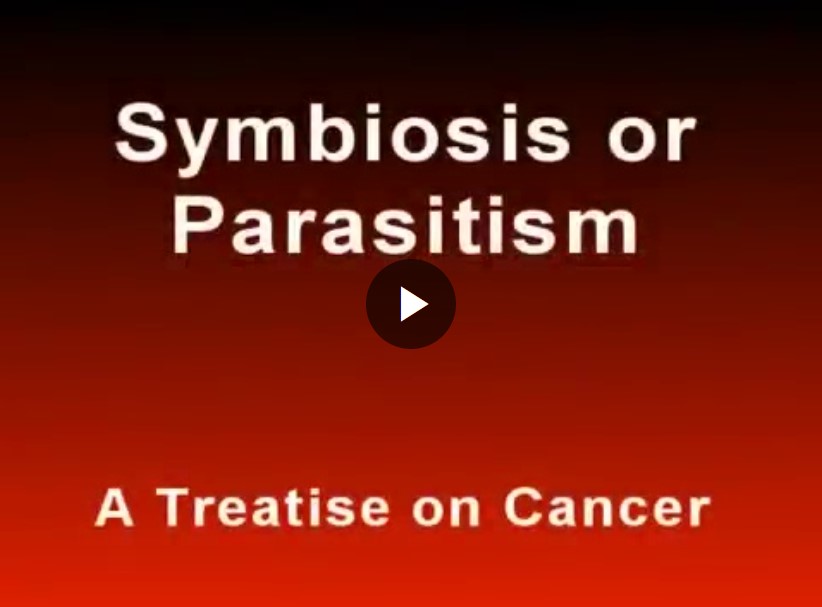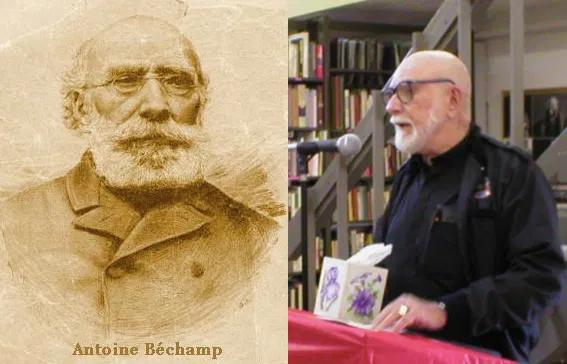08.09.2018: Dr. Robert O. Young: Viren und Bakterien unsere Freunde und Helfer – So belügt uns die Schulmedizin!
Von Youtube zensiert!
Seit 20 Jahren studiert der amerikanische Mikrobiologe und Biochemiker Robert Young das Verhalten menschlicher Zellen. Er entdeckte beispielsweise eine Anthraxbakterie im Blut eines Menschen, die sich vor seinen Augen in eine gewöhnliche rote Blutzelle verwandelte und nach einiger Zeit wieder zurück in eine Anthraxbakterie, je nach Zustand des sie umgebenden Milieus.
Was bedeutet das? Wer das Milieu beeinflussen kann, der kann bewusst zwischen Krankheit und Gesundheit wählen. Jeder kann das Milieu seines Körpers in jedem Augenblick selbst beeinflussen! Jeder ist folglich selbst verantwortlich für seine Krankheiten oder für seine Gesundheit.
Damit ist Prof. Antoine Bechamp bestätigt, der beobachtete, wie Bakterien je nach Säurezustand der Zellen sich aus roten Blutkörperchen bildeten – und zurück. Damit ist die Infektionstheorie von Pasteur und Koch widerlegt. Und das ist der Grund, warum die Erkenntnisse von Bechamp bis heute unterdrückt werden – man kann mit ihnen nicht so Geld verdienen wie mit dem Angstmachen vor ansteckenden Krankheiten, die von außen kommen!
Krankheit kommt nicht von außen, sondern aus uns selbst, aus unserem eigenen Blut – wenn das Milieu nicht stimmt!

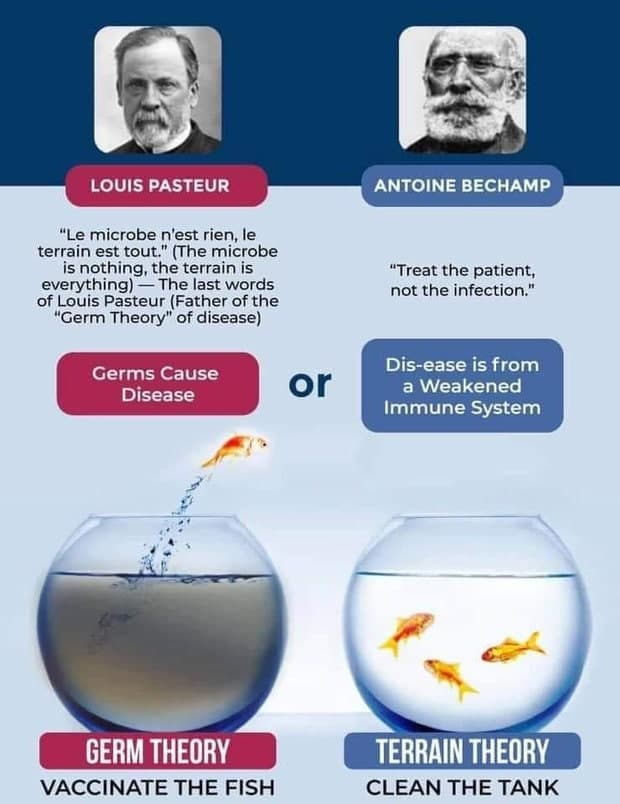
16.06.2017: Die Mikrobe ist nichts, das Milieu ist alles!
Ein Aufsatz von Kristina Peter
Text: Kristina Peter – Die Mikrobe ist nichts, das Milieu ist alles (2007)
Zitat: “Prof. Dr. Antoine Béchamp wußte schon vor über 100 Jahren: Krankheit kommt nicht von außen, sondern aus uns selbst, aus unserem eigenen Blut – wenn das Milieu nicht stimmt. Antoine Béchamps Forschungsergebnisse liegen wohlbehütet in den Katakomben der New Yorker Universität, wo keiner sie einsehen kann.
Béchamps Name wird sogar nach und nach aus der medizinischen Fachliteratur entfernt. Von Louis Pasteur hingegen hört und liest man regelmäßig. Die beiden Herren waren Zeitgenossen. Als Wissenschaftler waren sie völlig geteilter Meinung. Während Béchamp die Lehre des Pleomorphismus vertrat (und damit keineswegs allein stand), verkündete Pasteur beharrlich das Gegenteil – nämlich seine sog. Erregertheorie. Eine Theorie, der zufolge krankheitserregende Keime und Mikroorganismen wild und bedrohlich durch die Lüfte schwirren, völlig grundlos und unvorhersehbar mal diesen, mal jenen befallen und durch schärfste Maßnahmen bekämpft werden müssen. Eine Theorie, die das (wacklige) Fundament unserer heutigen Schulmedizin bildet.
Pasteur konnte seinerzeit seine auch „Luftkeimtheorie” genannte Ansicht deshalb durchsetzen, weil er im Gegensatz zu Antoine Béchamp Verbindungen zu einflußreichen Kreisen pflegte. Zu Kreisen, die rasch erkannten, daß aus Pasteurs Theorie ein unsterblicher, nie lahmender Goldesel zu machen war. Und so wird die Zahl der angeblich existierenden und krankheitserregenden Mikroorganismen täglich größer. Gleichzeitig wachsen die Ängste in der Bevölkerung, immer mehr Medikamente können auf den Markt geworfen und gewinnbringend verkauft werden.
Das alles wäre mit Béchamps Theorie nicht möglich gewesen. Hätte er sich damals durchzusetzen vermocht, gäbe es heute vielleicht keine Pharmaindustrie und nicht an jeder Ecke einen im Grunde hilflos behandelnden, aber niemals heilenden Schulmediziner.”
Weiterführend:
Die Mikrobe ist nichts, das Milieu ist alles! – Oder, warum Antibiotika nicht gesund machen bei bewußt – vegan – froh.
Ethel D. Hume: THE CULT OF THE MICROBE: THE ORIGIN OF ‘PREVENTIVE MEDICINE’
Stuart Grace: An Open Letter On Pleomorphic Microbiology. Unbundling The Enderlein Legacy, 2001, Natural Philosophy Research Group
Merinda Teller: Germ Theory Versus Terrain: The Wrong Side Won the Day
Pro Natura: Pasteur und Béchamp: Die Gegenspieler
1994: Dr. Robert O. Young: The Documentation of Biological Transformation or Pleomorphism
In 1994 Dr. Robert O. Young documented the biological transformation or pleomorphism of a red blood cell to bacteria and then back to a red blood cell.
Germs do not cause disease. Germs are the biological transformations of a polluted acidic environment. Watch this video and see a red blood cell become a rod bacteria (anthrax).

11.11.2020: Dr. Robert O. Young: Biological Transformation under Dark Field Microsocpy

Ethel Douglas Hume: Béchamp or Pasteur? A Lost Chapter in the History of Biology (1923)
R. B. Pearson: Pasteur: Plagiarist, Impostor. The Germ Theory Exploded (1942)

Philippe Decourt, Mitglied der International Academy of the History of Medicine, schreibt über das Buch “Béchamp or Pasteur?“: “What I was seeing while reading these documents stupefied me. My stupefaction increased even more while I was gradually studying the other discoveries which are attributed to Pasteur. Reality is quite different from the legend. A myth had been created and was repeated without checking anything. We were the victims of a huge hoax.”
Zu deutsch: “Was ich beim Lesen dieser Dokumentation sah, verblüffte mich. Meine Verblüffung nahm noch zu, während ich allmählich die anderen Entdeckungen studierte, die Pasteur zugeschrieben werden. Die Wirklichkeit ist ganz anders als die Legende. Ein Mythos wurde geschaffen und wiederholt, ohne etwas zu überprüfen. Wir wurden Opfer eines großen Schwindels.”
– Aus: Pasteur, the Stalin of medicine, Teil 1. Hier ist Teil 2.
Béchamp: “Die Mikrobe ist nichts, das Milieu ist alles!”
24.10.2017: Fehler in der Keimtheorie: Antibiotika, Virostatika und Impfungen

Keimtheorie vs. Milieutheorie am Beispiel von Goldfischen
Fisch impfen oder Tank reinigen?
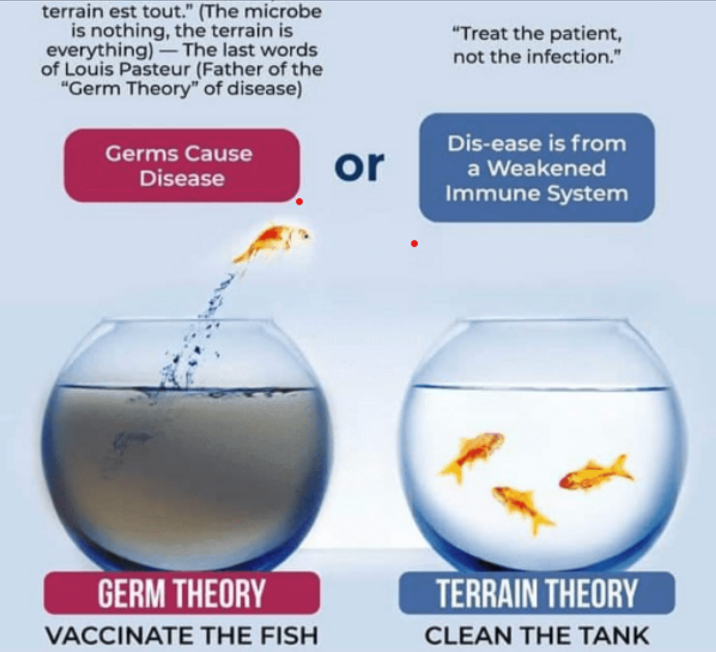
Mikroben – eigentlich Helfershelfer
Dr.-Ing. Joachim-F. Grätz
Dies hat James T. Kent mehr oder weniger schon vor über 100 Jahren seinen Studenten in den USA, wie folgt, erklärt: „Die Allopathen verwechseln Ursache und Wirkung, nehmen den Effekt für die Ursache und verfallen so einer falschen Theorie, der Theorie der bakteriellen Erreger. Man kann die Mikroben zerstören, ohne daß stattdessen die Krankheit vernichtet wird.
Die Krankheitsempfänglichkeit bleibt dieselbe, und allein diejenigen, welche empfänglich sind, können die Krankheit bekommen. Auch die Mikroben haben ihren Daseinszweck, denn es existiert nichts in der Welt, was nicht einen bestimmten Zweck zu erfüllen hätte. Weder Mikrobe noch Virus sind auf unserer Erde versetzt mit der ausdrücklichen Bestimmung, das menschliche Wesen zu zerstören. Die Bakterientheorie will uns glauben machen, die göttliche Vorsehung hätte diese unendlich kleinen Wesen geschaffen, den Menschen krank zu machen.“
Und an anderer Stelle: „… hier sei es nur gestattet, noch etwas Material zum Nachdenken anzuführen. – Wir wissen, daß eine bei einer Sektion zugezogene Wunde sehr ernsthafter Natur ist, wenn der Sezierte erst kürzlich verstorben ist. Man könnte annehmen, daß dies die Wirkung irgendeines Bazillus sei, dessen Virulenz so groß sei, daß er im Organismus eine Art Streptokokkenvergiftung (erysipelatous poisoning) erzeuge, die vernichtend ins Blut einbreche und das Individuum in einer Septikämie zum Erliegen bringe.
In Wahrheit ist es aber anders. Sofort nach dem Tode bilden sich Ptomaine, Leichengifte von Alkaloidcharakter, während von Bakterien keine Spur nachweisbar ist. Es ist also ein Gift da, und verletzt man sich beim Sezieren, ohne der Wunde sogleich die nötige Beachtung zu schenken, so läuft man Gefahr, sehr schwer, ja vielleicht tödlich krank zu werden. Ist hingegen der Kadaver so weit in Zersetzung übergegangen, daß alles von Bakterien wimmelt, so ist in diesem Stadium eine Verletzung beim Sezieren nicht mehr gefährlich. – Je mehr Mikroben da sind, desto weniger Toxine. Ein frisch gelöster Typhusstuhl enthält nur wenig Bazillen, ist hingegen sehr toxisch; wenn man jedoch wartet, bis er durch und durch voll Bakterien ist, dann ist er relativ gutartig.“
– Auszug aus: Dr.-Ing. Joachim-F. Grätz: Die vermeintlich bösen „Erreger“ – falsche Zielgruppe der Schulmediziner
Sachdienliche Literatur
Derek Henry: Germ vs Terrain Theory – Which Do We Adopt To Be Healthy?
Tony Isaacs: Louis Pasteur vs. Antoine Bechamp: Know the True Causes of Disease
Dr. Eddy Bettermann MD: The Illusion Of The Germ Theory
Dr. Eddy Bettermann MD: Book review: Doctors Are More Harmful Than Germs by Dr. Harvey Bigelsen M.D
Weitere interessante Ausführungen, warum die Hypothese von Keimen, Infektionen, Widerstandsfähigkeit und Immunität nicht stimmen kann, aus dem Buch The Hygienic System: Orthopathy by Dr. Herbert M. Shelton.
15.11.2019: Dr. Robert O. Young: Do Germs Cause Disease?
“The Work, Research, Discoveries and Findings of Robert O Young CPT, MSc, DSc, PhD, Naturopathic Practitioner Watch this video of a rod bacteria transforming into a red blood cell and then giving birth to a Y-form yeast, like candida albicans. All of this has been digitally videoed from a compound microscope using phase contrast microscopy.
The pH of the blood 7.310 (ideal 7.365) and the pH of the interstitial fluids 7.124 (ideal 7.2) These pH readings are significant because 1 point is a factor of 10X and an indication of metabolic acidosis or decompensated acidosis of the blood and body fluids.
To read more about interstitial pH and the true cause of cancer read, The pH Miracle for Cancer – www.phoreveryoung.com and “Alkalizing Nutritional Therapy in the Prevention and Treatment of Any Cancerous Condition.”
01.05.2012: Pleomorphism in Human Body -Mystical Science Pt6
“In blood & human tissues, small live particles can change into bacteria, yeast & fungal forms. These seeds of life mutate when the food supply varies. Poor food choice = illness. Raw foods & probiotics repair & protect digestive system.”
1991/2006: Symbiosis or Parasitism – Enderlein Polymorphic Milieu – Our Blood Microbes Change Shape and Action.
Komm. von Dr. Amanda Vollmer:
What are the processes involved that cause cancer? The concepts, shown in this film by Bernd Muschlien, discusses the processes as they have been seen under the Ergonom microscope – a light optical research microscope which allows viewing of living unstained organisms non-destructively at a very high resolution and magnification with enhanced depth of field and color contrast using the grayfield contrast method.
Thank you to Grayfield Optical – https://www.grayfieldoptical.com/
(Please keep in mind this company is still under the false illusion of viruses causing disease, which they DO NOT, they are RESULTS of a disease process in the body, as we are seeing from EMF blood attacks and chemical fall out from chemtrail metals and other poisons. You cannot catch these micro-organisms, they CHANGE form, inside of the body)
I want one of these microscopes! Goals!
The question begs, WHY don’t scientists, researchers, doctors, etc USE this microscope? Why don’t they study LIVE blood and darkfield microscopy? What are they hiding? Why have they been censoring the truth of our bodies and keeping humanity in the dark? Why are they STILL lying about contagion and the germ causing disease when it is a RESULT of illness?
Live Blood Online: https://livebloodonline.com/pleomorphism-and-germ-theory-explained/
Blood is NOT sterile – For a long time many researchers and doctors believed, and many still do, that blood is sterile. Professor Dr. Gunter Enderlein after numerous years of research proved otherwise. He showed using darkfield microscopy, that the serum of all people and warm-blooded animals are alive with many moving ‘particles’. He called these particles ENDOBIONTS (from the Greek “endon” = internal and “bios” = life). When you first look at a live blood sample under a microscope or on a monitor you cannot fail to see a multitude of moving, living particles. These are the Endobionts, and are an important part of health.
https://dreddymd.com/2017/01/13/is-blood-sterile/
As a blood smear slide ages over one to two days, organisms literally can be seen wiggling out of the red blood cells, organisms that change into more degenerate and pathological forms as the process proceeds. When the rotting or putrefaction process is over when there is nothing more for the newly formed viruses, bacteria and fungi to eat, they all break apart again, disappear, and turn back into the “little dots” they came from, the Protits/Microzymas/Somatids. They eat themselves.
1998: Dr. Stefan Lanka: Wahre Biologie – Viren oder Symbionten?
Was sind Viren? Wie werden sie isoliert? Machen sie Krankheiten?
Kritischer Vortrag über verschiedene Dogmen der Schulmedizin in einer Volkshochschule.
So etwas war also damals noch möglich.
Quellen:
1. Ausschnitt aus DVD “Die AIDS-Lüge“ (1998), mit freundlicher Genehmigung des Sternentor-Verlags:
http://sternentorverlag.com/product_info.php?products_id=206
2. https://www.youtube.com/watch?v=Qib_IEiP0k8
Ergänzend zwei Zitate:
Über die Viruskirche
1. “Wie ich seit 1988 sage und schreibe, sind verdeckte MEDIZIN-Aktionen langfristig die erfolgreichsten auf dem Planeten, wenn es darum geht, Menschen zu kontrollieren. Warum?
Weil das Medizin-Kartell keine parteipolitischen oder politischen Flaggen zeigt. Sie kündigt keine politische Agenda an. Es ist neutral. Es behauptet nichts anderes zu tun als zu heilen.
Sein Ableger, die Viruskirche, ist sensationell beliebt. Gleichzeitig ist für die Öffentlichkeit in der Kirche nichts zu sehen. Viren sind für das bloße Auge unsichtbar. Nur die Fachpriester können uns davon erzählen. Wir haben keinen Zutritt zum inneren Heiligtum, dem Allerheiligsten.”
– Jon Rappoport, Virus-, Impf- und Pharma-Aufklärer seit 1988, am 31.01.2020.
2. “Es gibt noch eine weitere Kategorie von Viren, die ich erwähnen sollte. Ich habe das in früheren Artikeln detailliert beschrieben. Es ist das Virus, das gar nicht da ist. Das ist das Schöne daran. Forscher führen verschiedene Verfahren durch, um es zu erkennen, aber diese Wissenschaftler erfinden MARKER, von denen sie BEHAUPTEN, daß sie indirekte Beweise für ein Virus seien, das sie nicht direkt festmachen können.
Aus solchen verrückten Prozeduren entsteht eine ganze Geschichte, ein Märchen und eine Legende über das Virus, das sie nie gefunden haben. Die Experten können sogar berichten, daß dieses nie entdeckte Virus eine globale Epidemie verursacht. Es ist zum Staunen.”
– Jon Rappoport, in: Viruses: a different perspective, March 3, 2020.
Weiterführend:
Gibt es krankmachende Viren?
https://impfen-nein-danke.de/gibt-es-viren/Dr. Johann Loibner: Was alles ist Virus?
https://impfen-nein-danke.de/loibner-viren
Fehlende Virus-Isolation
https://impfen-nein-danke.de/fehlende-virus-isolation/
Virus-Meineid
https://impfen-nein-danke.de/virus-meineid
Dokumentensammlung Virus-Beweisfragen
https://impfen-nein-danke.de/downloads2
Corona_Fakten
https://t.me/Corona_Fakten
Liste der wichtigsten Artikel
👉 Du findest uns hier:
https://t.me/impfen_nein_danke
https://impfen-nein-danke.de
https://odysee.com/@impfen-nein-danke
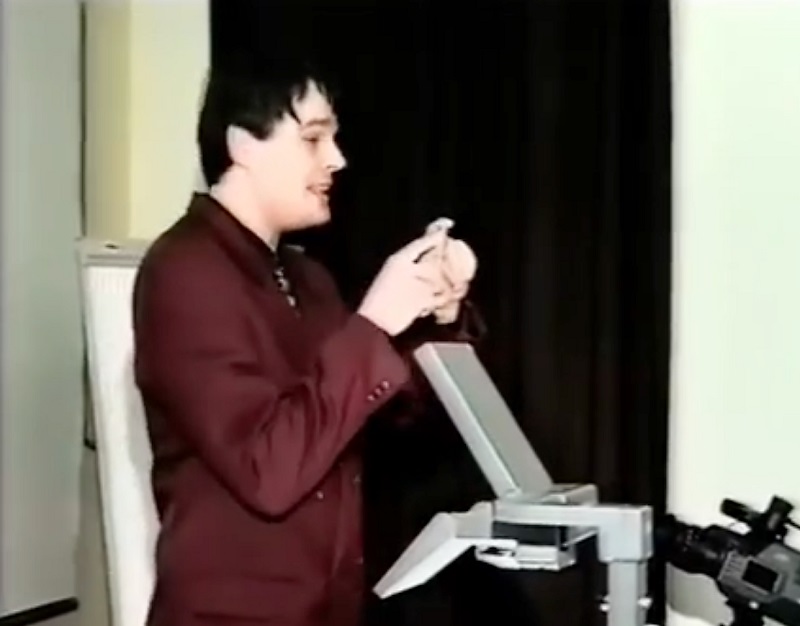
THE MICROBE
The Microbe is so very small
You cannot make him out at all,
But many sanguine people hope
To see him through a microscope.
His jointed tongue that lies beneath
A hundred curious rows of teeth;
His seven tufted tails with lots
Of lovely pink and purple spots,
On each of which a pattern stands,
Composed of forty separate bands;
His eyebrows of a tender green;
All these have never yet been seen —
But Scientists, who ought to know,
Assure us that they must be so …
Oh! let us never, never doubt
What nobody is sure about!
– Hilaire Belloc: MORE BEASTS FOR WORSE CHILDREN [1897], S. 47, bei archives.org.
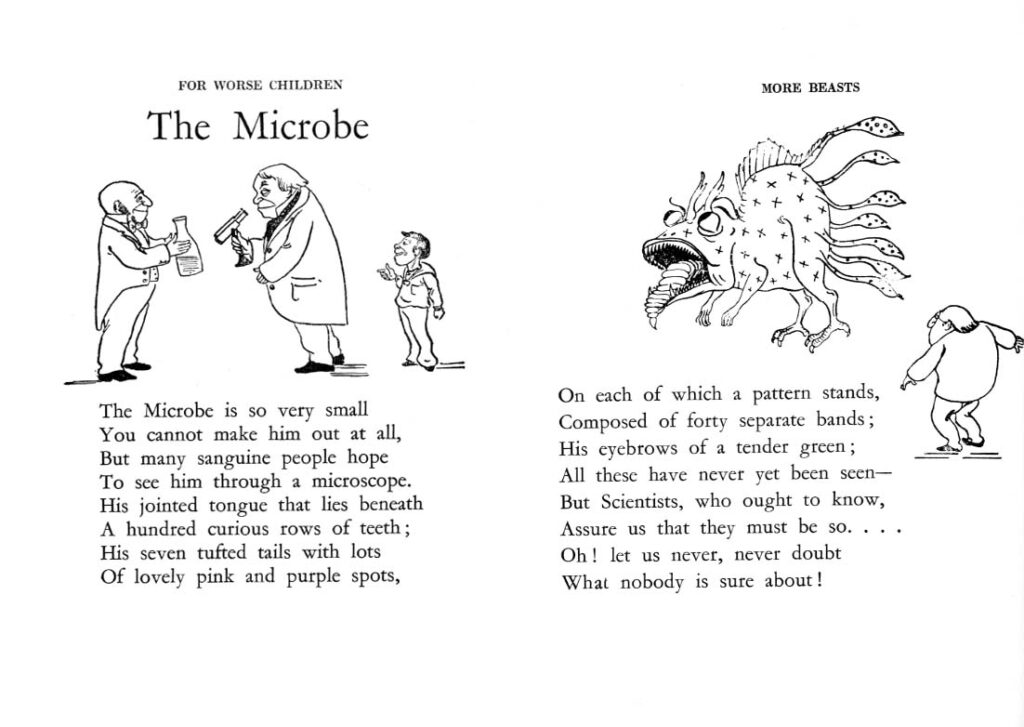
Bechamp’s Microzymas & Human Disease
By Alan Cantwell, M.D.
17 Mar 2017
Photos added by us from archive.
A century and a half ago Bechamp declared the microzyma is the essential unit of life. As a medical doctor, a microscopist and a cytologist (a specialist in the study of cells), he observed tiny, round granular bodies within the cells that glistened as tiny sparkles of refracted light. He was not the first to see the granules, but he was the first to suspect these “little bodies” might hold the key to the origin of life. Other scientists who observed these forms named them “scintillating corpuscles” and “molecular granulations.” Bechamp explored the nature and function of these granules contained within all human cells.
He studied them in various diseases. In tuberculosis (TB) the unhealthy cells contained large numbers of these granules. His varied academic background in medicine, chemistry and physics, and his special expertise in the use of polarized light, allowed him to devise unique biological experiments. Ultimately he showed that microzymas are tiny chemical factories which have the ability to ferment. Microzymas were named after Greek words meaning “small” and “ferment.”
Chemical tests proved microzymas were insoluble in water; and composed of hydrogen, carbon, and other elements, and produced nucleic acid. When heated to high temperatures they lost their ability to ferment. The microzymas were alive and teemed with chemically active energy. Bechamp declared that they were essential and indispensable anatomic cellular elements which digested, transformed, and assimilated nutrients required by the cells. He tried to kill them, but they proved indestructible. They were present in the amoeba, the smallest form of animal life; and within the smallest forms of plant life. Microzymas of each organ behaved differently from one another with different biochemical properties. The microzymas in the organs of young people differed biochemically from those in old people.
The transformation of microzymas into bacteria
Bechamp made a tremendous scientific discovery. Under certain conditions (and by a process known as “vibrionen evolution”) he observed microzymas transform into bacteria! First, they enlarged into round coccoid forms. Then the round forms might couple into two or more units; or they might sprout into rod forms of bacteria. Bechamp was sure the “little bodies” were involved in the fermentation process and in the production of disease.
Where do microzymas come from? He startled the scientific world by declaring: “They are the organized and yet living remains of beings that lived in long past ages. They are the transmitters of heredity. Within the chromatin material of the human sperm are contained all the microzymian granules needed to genetically reproduce all the different cells essential for the reproduction of the human species.”
Bechamp taught that all life arises from microzymas. After many laboratory experiments and microscopic examinations of these granules, the physician-scientist claimed that microzymas were capable of developing into common living organisms that go by the name of bacteria. Some of these intermediate bacterial stages were regarded by experts as different species, but to Bechamp they were all related and derived from microzymas.
Bechamp versus Pasteur
Antoine Bechamp (1816-1908) had an incredible list of scientist appointments at French universities: Doctor of Science, Doctor of Medicine, Professor of Medical Chemistry and Pharmacy at Montpelier, Professor of Physics and Toxicology at Strasbourg. The list goes on and on.
During his lifetime Bechamp was overshadowed by the iconic chemist Louis Pasteur (1822-1895), the most celebrated scientist of the nineteenth century. He is considered the Father of Medical Microbiology. And some call him the Father of Modern Medicine, a title quite remarkable as Pasteur was not a physician. Both men were highly-regarded members of the French Academy of Science, and each submitted their scientific findings to the Academy for review and publication.
Because Bechamp frequently criticized Pasteur’s work, an intense rivalry and feud between the two intensified in the Academy. But no matter how carefully Bechamp argued against some of Pasteur’s scientific methods and conclusions, the Academy always gave the nod to Pasteur.
As a chemist, Pasteur lacked Bechamp’s varied professional accreditations in the fields of biology, physics and pharmacology. Despite this, he achieved great fame by saving the French beer and wine and silkworm industries, and with pasteurization and vaccine research. He was consumed with fermentation experiments and with proving “air germs” were the basis for human disease, although he provided no explanation for the origin of atmospheric germs or how life began on Earth. In Bechamp’s view, Pasteur’s “air germs” had nothing to do with the origin and appearance of these microzymas in tissue. In fact, he wrote that Pasteur’s air germs most likely derived from dying life-forms. Adding more heresy to Pasteur’s dogma, Bechamp wrote that without oxygen, microzymas do not die—they go into a state of rest.


